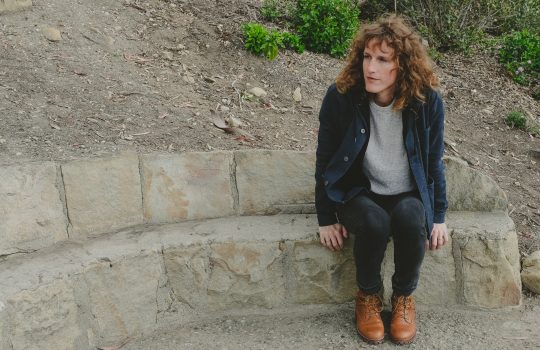
Katy MacKenzie’s photo of the Main Control Room at TRIUMF in Vancouver, Canada, won first place in the juried competition of the Global Physics Photowalk. Photo: Katy MacKenzie

Molly Patton’s image of drilling taking place in the Stawell Underground Physics Laboratory in Australia took first prize in the people’s choice competition of the Global Physics Photowalk. Photo: Molly Patton
In September, eight research laboratories from around the globe hosted over 200 photographers at their world-class facilities for a unique opportunity to go behind the scenes and capture the beauty of physics through the Global Physics Photowalk 2015. From thousands of submissions, each laboratory curated a shortlist of photos for the global competition. An international panel of judges of artists, photographers and scientists scrutinized the photos to crown winners in the jury category. A public, online vote determined winners in the people’s choice category.
First place in the jury category is awarded to Katy MacKenzie’s photograph of TRIUMF’s Main Control Room. For the Vancouver-based mortgage broker and hobbyist photographer, the photo yields childlike marvel and memories associated with visiting her father, since retired from his position as senior research scientist, on the job over 30 years ago.
“My father worked at TRIUMF,” MacKenzie said. “I have vivid memories of sitting on the floor of the Control Room watching him work. I was too young to tell time and imagined the clock was a countdown to some super secret mission launch.”
“This photograph speaks to the human experience and everyday qualities of work, science and technology,” noted juror Robert Bean, an artist, writer and professor at Nova Scotia University of Art and Design University in Canada. “The mix of analog and digital technologies,” he said, “is indicative of how scientific knowledge emerges from the hybridity of things. Alexander Graham Bell would approve.”
First time host Stawell Underground Physics Laboratory (SUPL) in Victoria, Australia, takes home second place with Mark Killmer’s photograph of the temporary laboratory set up in the Stawell Gold Mine.
“This photo serves as a fitting reminder that much science still involves people getting their hands dirty,” said juror Joe Hanson, a biologist, science writer and the creator and host of PBS Digital Studios’ science education series “It’s Okay To Be Smart.”
Third place is awarded to Robert Hradil’s photo The Incredibles. The photo, taken in the CERN restaurant, spontaneously captures the knowledge transfer between the past, present and future.
“Humanity is a collective process. There is a need of transferring ideas to make and create the world we live in,” said juror Jan Peters, a documentary filmmaker from Berlin.
In the people’s choice category, more than 3,800 online votes were cast to determine the winners.
First place is awarded to Molly Patton’s photograph at SUPL, revealing an electric mining drill. Patton was inspired by the underground laboratory as it “lights the way for dark matter detection and future particle physics research.”
Second place goes to Pietromassimo Pasqui’s photograph at INFN National Laboratory of Frascati, Italy, featuring a vacuum chamber and mirror carrying a laser beam for the SPARC accelerator.
Third place is awarded to Rosemary Wilson’s photograph at DESY in Hamburg, Germany, detailing a detector wire chamber that took data at the HERA collider from 1992 to 2007.
“This is an inherently beautiful image, strongly composed and skillfully photographed,” noted juror Yael Fitzpatrick, design and branding manager at American Geophysical Union. “It feels highly technical but also quite simply beautiful — an aesthetically pleasing image.”
The winning photos can be viewed along with more information about our judges at interactions.org. Photographs will be featured in symmetry magazine, in the CERN Courier, and as part of a traveling exhibit across laboratories in Australia, Asia, Europe and North America.
Congratulations to all winners and participants!
GLOBAL JUDGES
Robert Bean is an artist, writer and curator living in Halifax, Nova Scotia, Canada. He is a professor at Nova Scotia College of Art and Design University. Bean has edited books and published articles on photography, contemporary art and cultural history. He is a contributor to the Cineflux Research Group at NSCAD University and the Narratives in Space and Time art and mobility project. Bean was the artist-in-residence at the Canada Science and Technology Museum, Ottawa, in 2010. In 2014, Bean curated the exhibition “Stan Douglas Photographs” shown at the Ryerson Image Centre in conjunction with the Scotiabank Photography Award. Bean’s artwork is in public and private collections, including the National Gallery of Canada, the Art Gallery of Nova Scotia, ZKM (Zentrum für Kunst und Medientechnologie) Karlsruhe, Germany, and the Donovan Collection, University of St. Michael’s College, Toronto.
Yael Fitzpatrick is the design and branding manager at the American Geophysical Union, the world’s largest organization of Earth and space scientists based in Washington, DC. Fitzpatrick brings more than 25 years of design and management experience as a former art director and publications professional, including 18 years in scholarly publishing and communication, most recently at Science. Fitzpatrick has extensive experience with journals, magazines, and books in print and online, as well as expertise in content ranging from general daily news to highly technical academic research.
Joe Hanson is a biologist, science writer and the creator and host of PBS Digital Studios’ science education series “It’s Okay To Be Smart,” which takes a fun-loving look at the world of science through the lens of pop culture, art and comedy. Hanson’s award-winning writing has been published in WIRED, Nautilus and Scientific American. “It’s Okay To Be Smart” has been nominated for IAWTV and Streamy Awards for excellence in online video.
Keibun Miyamoto is a photographer, film director and novelist. Miyamoto was born in Saitama Prefecture Urawa, Japan, and attended the Nihon University – College of Art and the New York School of Visual Arts. He worked in New York for several years and later returned to Japan. Miyamoto’s photography portfolio includes advertisements, magazines, editorials, elevision and film.
Jan Peters is a documentary filmmaker from Berlin specializing in Super 8. Born in Hanover, he studied at the University of Fine Arts in Hamburg and co-founded Abbildungszentrum, a filmmakers’ collective, in 1994. Peters is also a radio play author and video artist. He is particularly known for his playful and experimental use of accident and imperfection to emphasize the film as a medium as well as his exploration of the dynamic between narrator and audience. Peters masterfully interweaves a documentary style with unexpected elements such as satire, monologue performances and forays into fiction, yet his oeuvre is constantly growing more diverse in style and content. Peters was awarded the Collide@CERN Geneva Award Winner in 2013.



